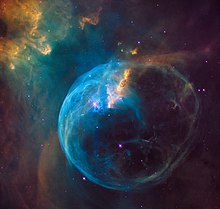Stellar-wind bubble
A stellar-wind bubble is a cavity light-years across filled with hot gas blown into the interstellar medium by the high-velocity (many thousand km/s) stellar wind from a single massive star of type O or B. Weaker stellar winds also blow bubble structures, which are also called astrospheres. The heliosphere blown by the solar wind, within which all the major planets of the Solar System are embedded, is a small example of a stellar-wind bubble.

Stellar-wind bubbles have a two-shock structure.[1] The freely-expanding stellar wind hits an inner firing shock, where its kinetic energy is thermalized, producing 106 K, X-ray-emitting plasma. The hot, high-pressure, shocked wind expands, driving a shock into the surrounding interstellar gas. If the surrounding gas is dense enough (number densities or so), the swept-up gas radiatively cools far faster than the hot interior, forming a thin, relatively dense shell around the hot, shocked wind.
References
[change | change source]- ↑ Castor, J.; McCray, R.; Weaver, R. (1975). "Interstellar Bubbles". Astrophysical Journal Letters. 200: L107–L110. Bibcode:1975ApJ...200L.107C. doi:10.1086/181908.

